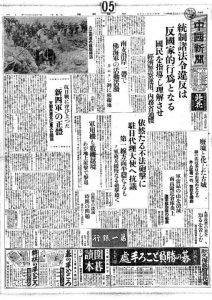94 years of August 6 front pages since 1930 now available on updated Peace Media Center website
Jul. 29, 2024
by Yumi Kanazaki, Staff Writer
The Chugoku Shimbun’s Hiroshima Peace Media Center has updated the section of its website that posts the front pages of the morning editions of August 6 and 7 for each year from 1946, the year after the atomic bombing, to 2023. The section now includes the newly added front pages of the morning editions of August 6 and 7 from 1930 to 1944 and of August 6, 1945, under the title “Front page since 1930.” People can now browse a total of 94 years of the front pages of the Chugoku Shimbun in PDF format.
The economic depression of Japan’s Showa period (1926∼1989) cast a dark shadow over the newspaper in 1930, the year before the Manchurian Incident. In 1938, the year following the outbreak of the Sino-Japanese War, when a general mobilization policy for the war effort had grown ever harsher, the paper wrote that “violations of governing laws and ordinances are acts of treason.” Especially after 1941, during the Pacific theater time of World War II, propaganda articles based on Japan’s Imperial Headquarters announcements were brought to the fore in the front pages.
The paper contained mostly distributed articles on Japanese military and political developments, but there were also articles describing the strenuous efforts of athletes in 1936, the year the Berlin Olympics were held in Nazi Germany.
The editorial in the morning edition published on the day in 1945 that Hiroshima was destroyed by a single atomic bomb stated, “The only path to victory in the war is to overcome this emergency,” despite the fact that Japan was already on the verge of surrender. There is no front page for August 7, 1945, because the paper’s head office in the central part of the city had been burned down the day before. Calling for the help of other newspapers to print on our behalf, the Chugoku Shimbun was able to resume publication on August 9.
A close look at the articles and headlines from the 15 years leading up to 1945 reveals Japan's consistent militarism and invasion of foreign territory long before the Pacific War, as well as the cooperation of the media, including the Chugoku Shimbun, in the war effort. After the war, the trend changed completely. The front page reported on reconstruction efforts under the occupation of the General Headquarters of the Supreme Commander for the Allied Powers (GHQ), movements against atomic and hydrogen bombs, and the annual Peace Memorial Ceremony. Hiroshima as a “military city” before the war and as the “A-bombed city” after the war―the newspapers always reflect the times.
(Originally published on July 29, 2024)
The Chugoku Shimbun’s Hiroshima Peace Media Center has updated the section of its website that posts the front pages of the morning editions of August 6 and 7 for each year from 1946, the year after the atomic bombing, to 2023. The section now includes the newly added front pages of the morning editions of August 6 and 7 from 1930 to 1944 and of August 6, 1945, under the title “Front page since 1930.” People can now browse a total of 94 years of the front pages of the Chugoku Shimbun in PDF format.
The economic depression of Japan’s Showa period (1926∼1989) cast a dark shadow over the newspaper in 1930, the year before the Manchurian Incident. In 1938, the year following the outbreak of the Sino-Japanese War, when a general mobilization policy for the war effort had grown ever harsher, the paper wrote that “violations of governing laws and ordinances are acts of treason.” Especially after 1941, during the Pacific theater time of World War II, propaganda articles based on Japan’s Imperial Headquarters announcements were brought to the fore in the front pages.
The paper contained mostly distributed articles on Japanese military and political developments, but there were also articles describing the strenuous efforts of athletes in 1936, the year the Berlin Olympics were held in Nazi Germany.
The editorial in the morning edition published on the day in 1945 that Hiroshima was destroyed by a single atomic bomb stated, “The only path to victory in the war is to overcome this emergency,” despite the fact that Japan was already on the verge of surrender. There is no front page for August 7, 1945, because the paper’s head office in the central part of the city had been burned down the day before. Calling for the help of other newspapers to print on our behalf, the Chugoku Shimbun was able to resume publication on August 9.
A close look at the articles and headlines from the 15 years leading up to 1945 reveals Japan's consistent militarism and invasion of foreign territory long before the Pacific War, as well as the cooperation of the media, including the Chugoku Shimbun, in the war effort. After the war, the trend changed completely. The front page reported on reconstruction efforts under the occupation of the General Headquarters of the Supreme Commander for the Allied Powers (GHQ), movements against atomic and hydrogen bombs, and the annual Peace Memorial Ceremony. Hiroshima as a “military city” before the war and as the “A-bombed city” after the war―the newspapers always reflect the times.
(Originally published on July 29, 2024)








